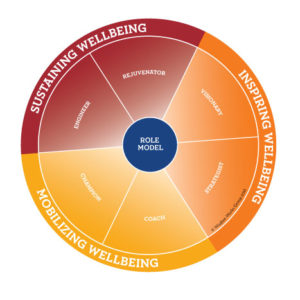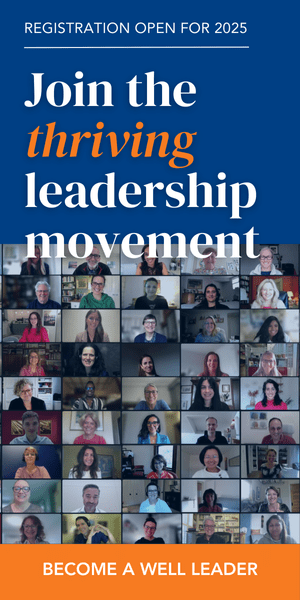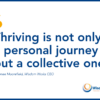 In last week’s blog, Attention Leaders: Are You Walking the Wellbeing Talk?, I talked about a forward-thinking consumer goods company whose executives understood how leading a culture of wellbeing could deliver financial and human results. But these same leaders weren’t sure how to walk the wellbeing talk as part of their leadership practice.
In last week’s blog, Attention Leaders: Are You Walking the Wellbeing Talk?, I talked about a forward-thinking consumer goods company whose executives understood how leading a culture of wellbeing could deliver financial and human results. But these same leaders weren’t sure how to walk the wellbeing talk as part of their leadership practice.
Yesterday, I spent time with a senior leader of a healthcare organization who’d come to the same conclusion: building a culture of wellbeing would require attracting, skilling, and motivating a new kind of leadership talent, leaders who could role-model and reinforce wellbeing not just as a company initiative but as an everyday, operational routine.
What needs to happen for these executives and companies to take the next step toward wellbeing? In our work, we find that those who understand 7 key leadership roles can create an environment of wellbeing where people thrive. The best part? Most leaders are already playing one or more of these roles; they just had not considered the roles as tools for enhancing wellbeing.
Take a look at the roles below and ask yourself: How well am I leading a culture of wellbeing? Consider the other leaders in your organization too: how well do they lead wellbeing?
1. VISIONARY
Creates and follows an inspiring vision of success that blends an ambition for wealth with a clear agenda to enhance wellbeing.
Ask yourself: Does my organization have a larger vision that includes the aspiration of wellbeing, and do I (and the leaders I work with) actively use it to guide business priorities, decisions, and actions?
2. STRATEGIST
Crafts wellbeing strategies built on the needs and motivations of employees, communities, consumers, and partners.
Ask yourself: Do I have the finger on the pulse of stakeholders’ initiatives and realities when it comes to wellbeing? And do I and other leaders turn these insights into wellbeing strategies that can really make a difference?
3. CHAMPION
Drives visible enthusiasm about wellbeing across the organization using formal and informal channels.
Ask yourself: Am I effectively using communication channels and social networks of influence to spread the wellbeing word and tap into a deeper passion for wellbeing within the people of my organization? Do other leaders do this?
4. COACH
Helps employees develop and use a wellbeing mindset and behaviors.
Ask yourself: Do I know how to coach individuals real-time to turn situations of reactivity, exhaustion, and stress into wellbeing moments? Can other leaders in my organization coach this way, too?
5. ENGINEER
Builds the infrastructure, capabilities, and workplace practices to scale wellbeing behaviors across everything they do.
Ask yourself: Do I know how to engineer workplaces and operations with wellbeing top of mind? Are other leaders helping to engineer for wellbeing, too?
6. REJUVENATOR
Actively uses wellbeing practices as fuel for innovation, learning, and renewal.
Ask yourself: Am I and other leaders doing what we can to create work environments where people grow and renew as human beings, rather than become marginalized or depleted?
7. ROLE MODEL
Strives to live wellbeing in all areas of life and work personally.
Ask yourself: Am I setting an example that opens up new wellbeing-inspired paths for others? Is the leadership in my organization a walking example of the importance of wellbeing to people and our company?
Based on your answers to the questions above, how well do you think you’re doing when it comes to leading wellbeing?
If you’d like to learn more about how these key leaderships roles could help you build a culture of wellbeing—and to find out more about how you and your team stacks up, download our free Leading Wellbeing™ Framework. You may be surprised by what it reveals.
READ MORE
• How Nike’s Jorge Casimiro Finds His ‘Inner Pre’
• The Secret Leadership Fuel of Scott Pann
• Why the Way We’re Thinking About Wellbeing May be All Wrong






